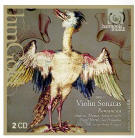Texte paru dans: / Appeared in: |
|
|
Reviewer:
Robert
Maxham In his notes to this disc. Manze discuses the role of improvisation in Baroque performance and compares these sonatas by Biber to written improvisation. He describes Biber as quick of wit and elbow. How better to describe Manze himself? He's certainly brilliant and imaginative in extravagantly inventive works (although comparatively less convincing in anything that's beautifully simple or simply beautiful). This set of Biber's most ingenious and technically prodigious sonatas ought therefore to call forth Manze's best efforts. In fact, they do. The performance begins at a pitch of frenzied excitement at which most interpretations close and builds from there. In annotating my Want List this year, I referred—not entirely in jest—to Heroes by Mark O'Connor and friends (Warner Bros. 9 45257-2) as a possible candidate: inspired vamping has been in short supply in recent recordings by “star“ violinists. But if Manze continues to play with the white-hot inspiration of these Biber discs, nobody will be candidate next year—he'll have the entire list to himself. Unlike many of his period-violinist confreres, he can produce all the variations of off-the-string bowings that his vivid imagination can conjure. What's more, he can make his tart whinings as palatable as the most silken cantabile. He isn't Heifetz, of course; but then, Heifetz wasn't Manze, either. In the future, he'll need to find more madcap material. No problem. He hasn't recorded Biber's Mystery Sonatas yet, and he hasn't even begun, at least on disc, to explore Walther. Veracini might also provide a runway for his high-flying fancy (as Luigi Mangiocavallo has demonstrated, Fanfare 14:1, p. 414-15). These unfamiliar Biber sonatas, so fitting a vehicle for Manze's virtuosity, themselves deserve a word or two of introduction. Like the Mystery Sonatas, they typically begin with improvisatory toccatalike figuration over bass pedals, followed by a succession of fast movements and sets of variations—dance movements are fewer than in Biber's other sonatas. The virtuosity transcends mere showmanship (though there's plenty of that, too) and makes an impression deeper than mere sideshow flimflam. It's hard to imagine an audience of Mark O'Connor's fans turning their backs on these electric performances—or the sonatas themselves—though they might not stay for the whole show. This meeting of volatile minds—the composer's and the interpreter's—really sets off Roman candles. The discs include the Sonata Representativa, a lute arrangement of the Passacaglia from Sonata VI, the sonata La Pastorella, and the now frequently recorded unaccompanied Passacaglia published with the Mystery Sonatas. When I reviewed Ensemble Saga's recording of the Sonata Representativa, (Fanfare 17:5, pp. 116-17), I compared it unfavorably to Reinhard Goebel's reading with Musica Antiqua Köln, which is startlingly realistic. But Romanesca's version sweeps everything before it. I still prefer Ensemble Saga's Maria Lindal in the Passacaglia, though, even if she doesn't build so relentlessly to the conclusion. Last year, it was Torelli in San Petronio (Fanfare 17:6, pp. 263-64) that caught my fancy. Early as it is, it's hard to imagine anything much better than this Biber set coming down the pike this year. The recording is first-rate and, although I've focused my attention on Manze, the sonorous support of Toll and North is a miracle of collaborative good fellowship. Recommended with uncommon urgency. | |
|
|
|
|
|
|
|
Cliquez l'un ou l'autre
bouton pour découvrir bien d'autres critiques de CD |
|




